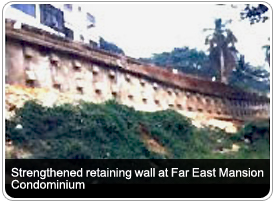Pressure Grouting
Pressure grouting is a general term for grouting into soil with applied pressure. The advantage of pressure grouting is it involves low pressure, generally ranges from 1 bar to 30 bars. This is much lesser than the pressure required for jet grouting, which is about 300 bars or higher. Hence the ground disturbance caused by pressure grouting is much lesser. Pressure grouting also requires much smaller plant and machineries than jet grouting or deep cement mixing method. Hence, it is often chosen for site where space is a constraint and/or near to structures sensitive to ground disturbance. It has been widely used at areas near to existing utilities services, old buildings, MRT tunnels and busy expressway.
Presscrete Engineering Pte Ltd provides 3 general types of pressure grouting, namely:
(a) Permeation Grouting
(b) Compaction Grouting
(c) Chemical Grouting
The grouting can be carried out via a grouting pipe confined within a soil mass, or a grouting pipe confined by an inflatable packer. For a grouting pipe confined by an inflatable packer inside a pre-installed borehole casing, it is commonly known as Tube-a-Manchette (TAM) grouting method.
(a) Permeation Grouting
Permeation grouting is a technique whereby low viscosity grout material is permeated into the void of soil particles via applied pressure. It is more suitable for soil with high permeability, such as sand and granular materials. The grout will reduce the porosity of the soil mass, hence reduces its permeability and increases its shear strength.
It is also suitable to fill up the fissures of fractured rocks; hence it is also called Fissure Grouting. The permeation grouting can be carried out in an overlapping, continuous pattern, to form a grout curtain. In this form, it is also called Curtain Grouting.
Applications:
Presscrete Engineering Pte Ltd carries out permeation grouting generally to mitigate the following problems:
i) To reduce the soil permeability of a soil susceptible to running sand and water ingress problem
ii) To increase the strength of sandy and granular soil
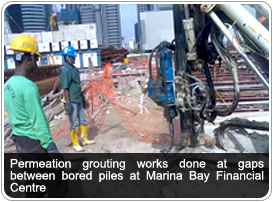
(b) Compaction Grouting
Compaction grouting is a technique whereby stiff, high viscosity grout material is injected into the soil mass. It is more suitable for soil with low permeability, such as clayey soil materials. The injected grout will form a grout bulb, which is stronger than the original soil mass. In addition, grout bulb displaces and compacted the surrounding soil mass, hence increases its density, shear strength and bearing capacity.
Applications:
Presscrete Engineering Pte Ltd carries out Compaction Grouting generally to mitigate the following problems:
(i) To improve the bearing capacity of soil
(ii) To mitigate the settlement problem of existing buildings
(iii) To increase the soil strength for excavation support
(c) Chemical Grouting
Chemical grouting is a technique whereby fast setting grout is injected into soil mass with water gushing problem. The grout will be injected via permeation or compaction mechanism, depending on the permeability of the insitu soil. The procedures of works are similar to that of permeation or compaction grouting. The main difference is a “two-liquid” grouting pump is used to ensure that the fast setting grout is mixed only at the pump outlet to minimize the problem of grout set within the grouting pipe. The injected grout will reduces the soil permeability hence mitigate the water gushing problem.
Applications:
Presscrete Engineering Pte Ltd carries out chemical grouting generally to mitigate the following problems:
(i) To mitigate water gushing problem at gaps of retaining wall during excavation
(ii) To mitigate water leaking at excavation shaft or basement slab

Deep Cement Mixing
Deep cement mixing is also called deep soil mixing. It is a method to improve the soft soil by mechanically mixing it with cement grout. A grout pump will supply the cement grout, and a piling machine with an attached auger will mix the soil with grout under the ground. As this method involves bigger plant and machineries, it is typically used for larger scale ground improvement works.
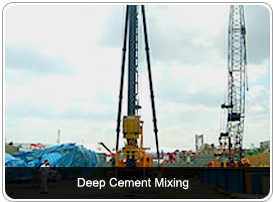
Micropiles
Micropiles are essentially small diameter foundation piles which are used in difficult ground and working conditions such as when there are space constraints. They are widely used in underpinning, which provides additional foundation support to structures; in upgrading and retrofitting; as well as in ground where there are boulders or rock. In addition, micropiles in rows can be used as retaining walls.
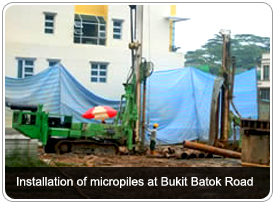
Ground Anchors and Soil Nails
Ground anchors are essentially steel tendons that are grouted in the ground and can transmit tensile forces from a main structure to the surrounding ground. Soil nails are usually steel elements such as bars grouted in boreholes to reinforce the ground. Ground anchors and soil nails are used as lateral supports for retaining walls, to resist upward forces acting on basement structures, to stablise slopes, as lateral supports for marine structures and to anchor foundations to resist overturning forces.
 |
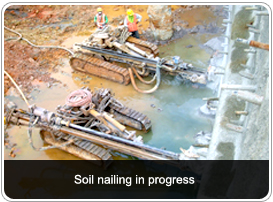 |
Jet Grouting
Jet grouting is a ground improvement technique which involves the injection of cementing mixes under high pressures and with high velocities into soft grounds to improve the mechanical characteristics of the ground. The jet grouting technique has been successfully applied in soft marine clay and loose sandy soils.

Retaining Wall Systems
Conventional reinforced concrete walls can generally be constructed where there is no space constraint. However, for areas with difficult access, confined working space and poor ground conditions, an innovative approach is required. The Company designs and installs specialised retaining wall systems such as topdown reinforced gunite walls, anchored crib walls, precast buttress walls and soil nailed retaining walls. These walls are tailored by the Company’s design team to suit particular site conditions and to fully exploit the specialist engineering techniques available to the Company.
